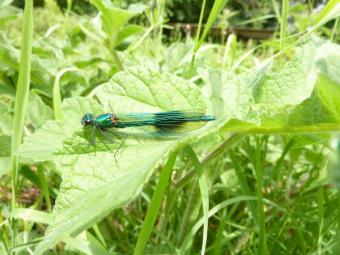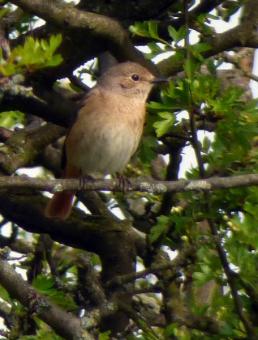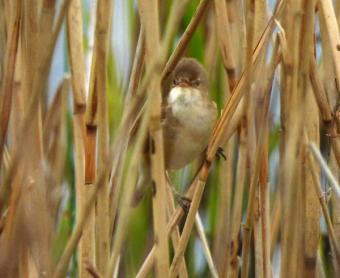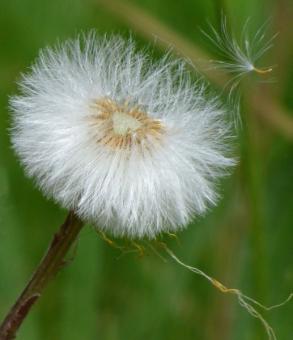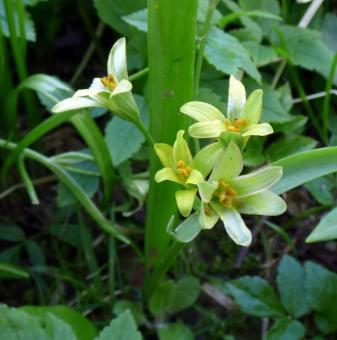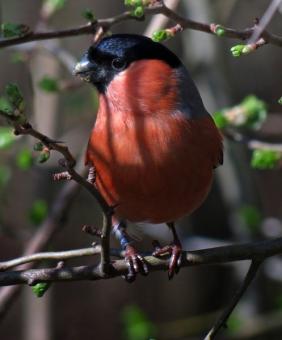 Spring Gentian
Spring GentianThe BEES group last visited this site in May 2009, before I joined them. I had long been aware of the botanical rarities of Upper Teesdale so was eagerly looking forward to my first ever visit to this special place.
Though it had been raining slightly before our full bus left Bradford, as we headed north along the A1(M) it began brightening up. Prospects therefore looked good! Our route took us past Scotch Corner, Barnard Castle and many scenic stone propertied villages before arriving at Moor House NNR near Cow Green Reservoir; where we were met by our guide for the day Lynn Patterson. She is a volunteer for Natural England. As it was approaching 12:30 we all ate our lunches in or around the mini-bus. Maddie generously gave out her home-made fudge. Use was also made of the Tardis like portaloo.
This is a very exposed area at over 1,500 feet but even so I was taken aback by the strength of the south-westerly wind. It certainly took Amanda by surprise as her empty white plastic bag was whipped away and shot up the hillside seemingly headed for Scotland! She rather gamely chased after it but soon realised her cause was hopeless! Almost as soon as we headed off in the direction of the reservoir it began to rain. Unfortunately this was not rain landing on our heads but the sort that smashed into us at right angles. To illustrate my point, it blew Janet onto her back as she was stepping over a grassy mound. No damage to the mound or Janet!
This was the trigger to cause Janet, Philip,Margaret and Robert to immediately head back to the shelter of the bus. Gillian very quickly joined them! Although my somewhat unsuitable trousers were very soon sodden I was determined to carry on in order to see some of these rarities (The Teesdale Assemblage), in particular the Spring Gentian. Fortunately they were abundant amongst the numerous violets and pansies. Obtaining decent pictures of them, however, was quite another matter. Whether it was the appalling conditions or the vivid blue colouration of the petals I struggled to get them in focus. By the time I had taken at least 15 photos the group were disappearing in the distance so I hurried after them. Stuart, who had escorted Gillian back, also rejoined the drenched group.
The rain had been hitting us from the side but as we neared the shores of the reservoir it was now full in our faces! That was enough for Steve, our newest member and also for myself; so we too headed back to the bus. We had spent less than 30 minutes walking. Within an hour everyone else returned also. They had got as far as Cauldron Snout waterfall (not Cauldron Spout as certain persons kept calling it!). The brave souls who reached the end were Stuart, Donald, Julia, Amanda, Sally and Maddie.
Alice had marvellously recorded 27 plants in flower and was the only person who saw a solitary diminutive Moonwort and also Mountain Everlasting, both rarities and the latter a first for Alice. The species list included; Birds-eye Primrose, Spring Sandwort, Hare's tail Cotton Grass, Lesser Clubmoss, Mountain Pansy, Dog Violets and Wild Pansy.
As we departed a small flock of Golden Plover flew past. The only birds of note we had seen. Sue, our principal photographer, had very early on decided that her camera was not leaving it's case!
Our next destination was High Force. This spectacular waterfall was in full spate. The weather here was fairly pleasant and we even saw a white butterfly. Some good birds were also sighted including Blackcap, Treecreeper and Spotted Flycatchers. There is a £1.50 charge to enter this private estate. The falls are easily reached within 5 minutes. Plants seen here were: Sanicle, Yellow Pimpernel, Greater Wood-rush and Globe Flower.
We arrived at The Tiger Inn, near Knaresborough earlier than we had planned but we didn't have long to wait before being shown to our table. Everyone later agreed the meal had been of a very high standard. In order to ensure we were not too late getting back we had agreed only to have a main course. Sorry Robert but your Jam sponge and custard will have to await another day! Sue did treat us to her home-made mince pies and carrot cake before we left the car park.
Many thanks go to the joint leaders Julia and Alice to whom I bear no ill will for the dreadful weather! Also to the three drivers who shared the load: Stuart, Robert and Julia and not forgetting our guide for the day Lynn
An eventful day out. See the photos here.
John Gavaghan


